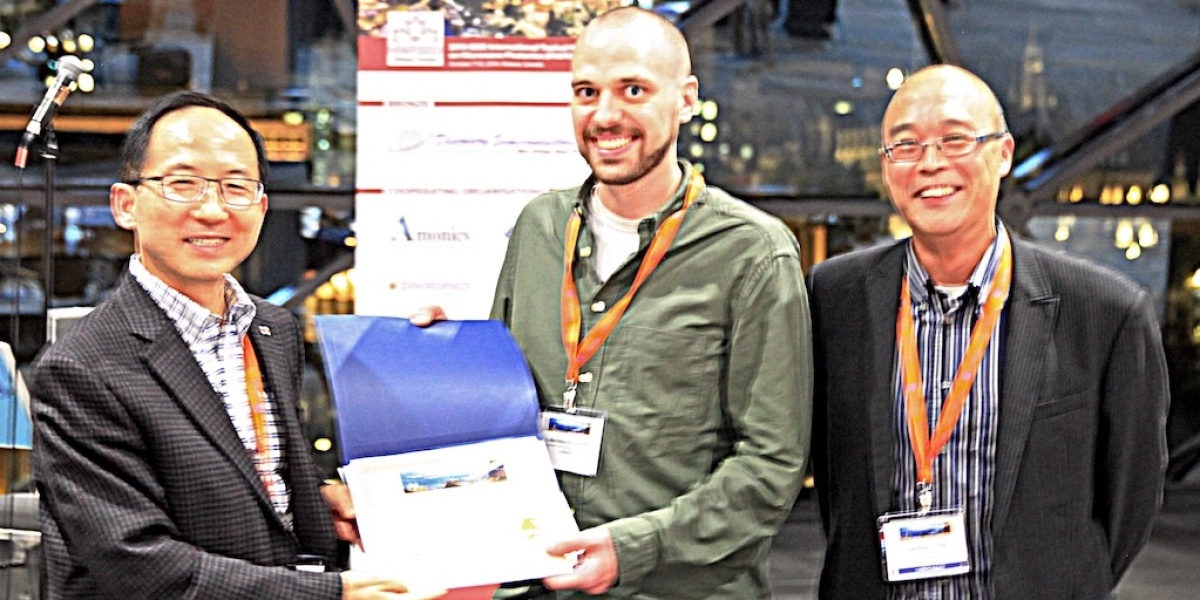Press releases
Sebastian Dülme wins Best Student Paper AwardNovel low-noise, photonic two-tone terahertz spectroscopy and imaging system.
Microwave photonics is an interdisciplinary field that deals with the interaction of microwaves and light waves in the generation, processing, control, and propagation of signals in the terahertz as well as micro- and millimeter-wave range. Microwave photonics is found in many applications, such as high-speed wireless networks, spectroscopy and imaging, radar, sensors, and advanced instrumentation.
The IEEE International Topical Meeting on Microwave Photonics (MWP) is the premier international meeting on microwave photonics and provides a presentation platform for new developments in this multidisciplinary research area, from new devices to field trials. The MWP venue rotates every three years between Europe, the Americas, and the Asia-Pacific region, and this year was in Ottawa, Canada, from October 7-10. The University of Duisburg-Essen was represented in Ottawa by three members of the Center for Semiconductor Technology and Optoelectronics: Sebastian Dülme, Matthias Steeg and Prof. Dr. Andreas Stöhr had traveled to present system and technology developments from the field of optoelectronics in recent months. Work from the fields of millimeter-wave radar and millimeter-wave beam deflection for 5G applications using photonic leaky-wave antennas as well as photonic terahertz spectroscopy and imaging systems were presented.
Special recognition was given to the development of a novel photonic two-tone terahertz spectroscopy and imaging system, which earned Sebastian Dülme the "Best Student Paper Award (2nd Place)" for his paper "300 GHz Photonic Self-Mixing Imaging-System with vertical illuminated Triple-Transit-Region Photodiode Terahertz Emitters".
The novel photonic two-tone terahertz spectroscopy and imaging system presented by Sebastian Dülme, currently a PhD student in the Department of Optoelectronics at the University of Duisburg-Essen within the Collaborative Research Center Mobile Material Characterization and Localization by Electromagnetic Sensing (SFB/TRR 196 - MARIE), funded by the German Research Foundation (DFG), enables extremely low-noise amplitude and phase values to be determined. Due to the low phase noise of the presented system, smallest changes of e.g. the complex permittivity or the thickness of the objects under investigation can be determined. The system is based on the detection of two terahertz signals by means of an envelope detector, which mixes the terahertz signals down to a low-frequency signal, in which the phase information of the terahertz signals is still contained. In contrast to conventional coherent systems, this eliminates the need for a space-consuming optical delay line and achieves a significant reduction in phase noise.
Powerful and ultra-fast terahertz photodiodes developed at the Center for Semiconductor Technology and Optoelectronics were used for the necessary generation of the terahertz radiation. Photodiodes represent key elements in many terahertz photonic systems for e.g. communication, radar, spectroscopy and imaging applications, where they are used to generate terahertz waves via optoelectric conversion. The characterization of the indium phosphide-based terahertz photodiodes was partly carried out in cooperation with the Optoelectronic Device Group chair of Prof. Dr. Andreas Beling at the University of Virginia in Charlottesville, USA, which Sebastian Dülme visited during a research stay (Short Term Scientific Mission) in December 2018. The achieved flat frequency response of the photodiodes in the J-frequency band (225 GHz to 330 GHz), enabled the use of the presented two-tone terahertz system at 300 GHz. In addition to the experimentally obtained results, numerical simulations of the semiconductor physics of the device have also been presented at the conference.
Future work in this area, in addition to further performance optimization of terahertz photodiodes, will include their integration with other material systems, fabrication of fiber-bonded photodiode modules, development of photodiode arrays, and realization of terahertz electromagnetic beam steering.
Contact: Andreas Stöhr

